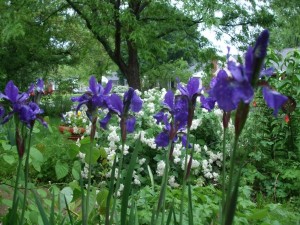A few, nearly record-setting 80-plus degree days pretty much pushed Hoosier gardens from mid-spring to late spring. The Camassia came and went within a week.
Although the season is rushed, the good news is that there’s been a rush of customers at the garden center. After weeks of rain and chilly temperatures, the customers are ready to plant something, anything. During the cooler days, when it was too wet to work in the yard, customers would come in just to walk around the plants in the greenhouse.
For years, I used to get my plant fix at my Uncle Bill’s commercial greenhouses, where seedlings began to take shape as petunias, impatiens, tomatoes or peppers. Pots of cutting geraniums carpeted the floors of the greenhouses, which kept plants at just the right temperatures for blooming in unison on the sales benches.
Mother Nature is not quite so controllable.
So, this morning I braved a nice gentle rain to snap some photos of the colorful aspects of today’s dreary landscape.
No matter how many pictures I took, I could not capture the intense blue of ‘Caesar’s Brother’ Iris siberica. This Siberian iris makes up for its short bloom cycle by developing glorious red foliage in fall.
Across the walk from ‘Caesar’s Brother’ is Snow Storm (Spiraea media ‘Darsnorm’), one of several garden worthy spirea from Proven Winners/ColorChoice Plants. This one gets about 3 feet tall and 4 feet wide. In May and June, it is covered with large, 5- to 6-inch wide white flowers above bluish-green foliage. This is an extremely tidy plant that retains its good looks even when the flowers fade. In fall, it turns a beautiful reddish yellow.
For the first time, my Arkansas bluestar (Amsonia hubrichtii) has bloomed. This is its third year, but the plant was quite small when it went into the garden. It sits next to the Eastern bluestar (Amsonia tabernaemontana), an unnamed variety I got from the Holden Arboretum several years ago at a regional meeting of Garden Writers Association.
As many of you know, the Amsonia hubrichtii is the 2011 Perennial Plant of the Year. This fernleaf perennial not only blooms and adds texture to the garden, it extends its seasons of interest by turning a lovely golden yellow in fall. Really, the texture and fall color alone make this a garden worthy perennial.
A few Spanish bluebells (Hyacinthoides hispanica) have popped up amid the Japanese painted fern (Athyrium niponicum ‘Pictum’) Tiarella and Epimedium. Even though these bluebells arrive on the scene late, they seem to last a decent length of time.
Rain-drenched poppies (Papaver orientalis), a favorite spring bloomer needs a companion, which is on my to-do list. Of course, the native columbine (Aquilegia canadensis) is blooming, along with Corydalus lutea.
Thanks to Carol at May Dreams Gardens for being the host of Garden Bloggers’ Bloom Day the 15th of every month. Join in by posting what’s happening in your garden.




Some how I think the sheets of ice this winter protected some of my perennials..they are doing so well..spectacular is the word..what do you think
Those irises sound pretty as does that spirea. Thanks for braving the rains for bloom day. (I took my pictures yesterday, when it was still dry outside.
Thanks for sharing your rain garden. lol. I have struggled with Caesars brothers, that is to get it established. Tried one bare root early and one in a pot. both died. have anther variety that seems to have taken place. happy gardening.
Beautiful blooms! Happy GBBD 🙂
I am so SO jealous of your poppy…try as hard as I might, I cannot get them to grow 🙁